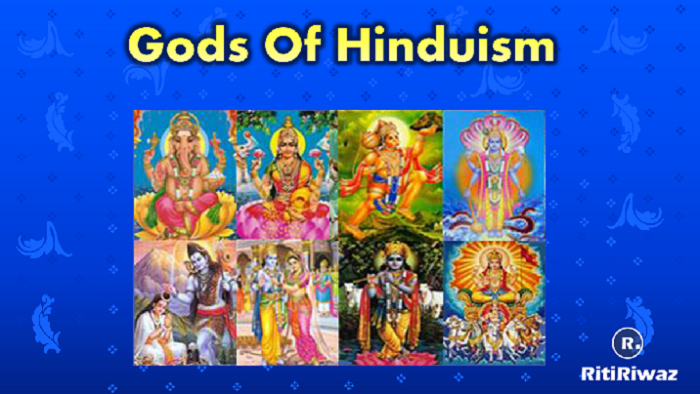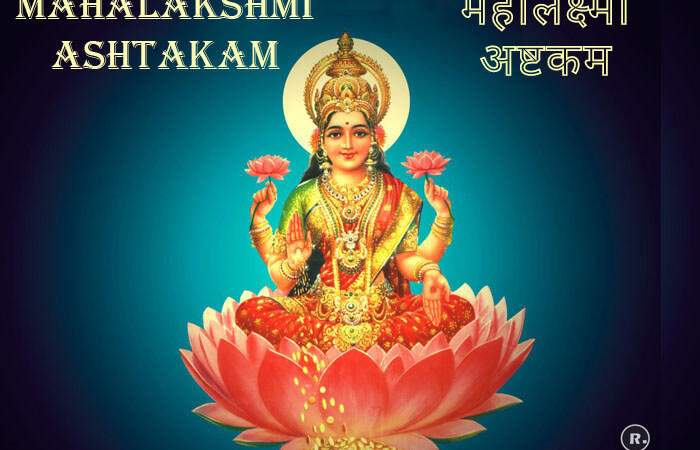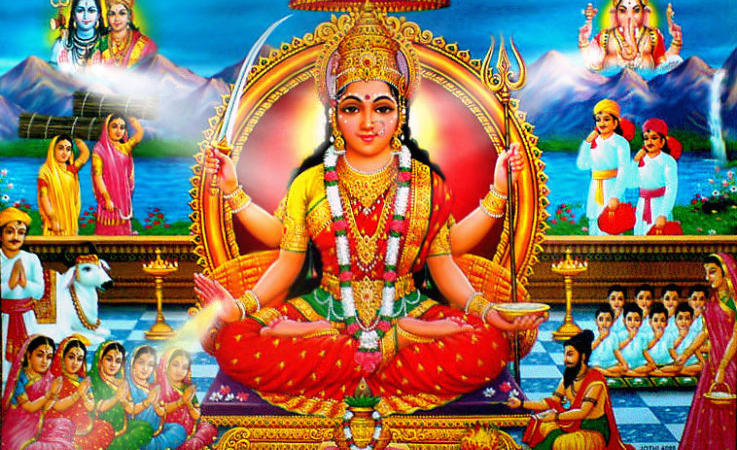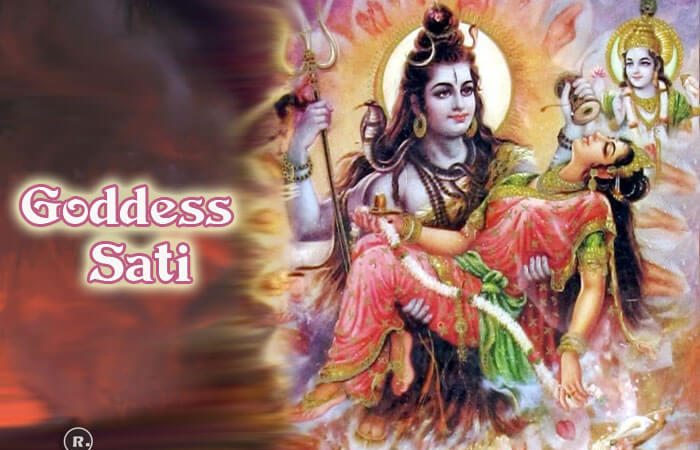Gods of Hinduism

To an uninformed observer, Hinduism may appear chaotic and polytheistic. In a sense India is God-intoxicated, there is god everywhere, in all things. There is god for vegetation, gods for the weather, gods for nature, gods for geographical areas, gods for villages, gods for the house, gods in the temples, gods in running water, god in the deepest forest, and in icy mountain heights. There is no place where God doesn’t exist, god inspires, gods infuse art and creativity and gods provoke destruction too.
However, there is indeed a structure behind this apparent endless profusion of divinity. Fundamentally Hindus believe in a Universal God and this belief is derived from the Vedic philosophy of the World Soul. The hundreds of gods portrayed are faces of the same single force, the Universal God. This God is all-pervasive, omnipotent, and omniscient, in the true Vedic sense (sarvantharyami).
A Hindu will see the power of God in everything that surrounds him, animate, or inanimate. Animals like cows, monkeys, or snakes may be considered sacred and even an ordinary stone may hold the power of God. The all-pervasive God is the creator of all matter and everything created by the Universal God represents a part of Him. This may appear as idolatry to a Western observer, whose religion generally condemns it, but a Hindu worships the Spirit that the idol represents rather than the idol itself. It only gives the worshipper a channel or a symbol to concentrate on during his prayers and meditation.
Trimurti
All the manifestations of power in this universe can be resolved into three called Trimurti: 1) creation, 2) preservation, and 3) destruction. Brahman, or God, is the only reality. So one should be able to perceive God in all three manifestations of power. This is described in a personal way by associating creation, preservation, and destruction each with a particular aspect of the Godhead. The creative power is called Brahma. The sustaining power is called Vishnu, and the destructive power is called Shiva.
Brahma is the creator of the world. He only occasionally interferes in the affairs of the gods, and even more rarely in mortal affairs. Brahma is an agent of Brahman, the Supreme Being or Absolute of Hinduism. His worship has considerably decreased in India, in comparison with Vishnu and Shiva. Brahma is usually depicted with four heads.
Shiva is almost as popular as Vishnu and is evolved from the fierce Vedic god Rudra. Residing in the Himalayan Mount Kailasa, Shiva is a great ascetic, always meditating for the welfare of the world. He is covered with ashes and from his matted hair flows the sacred river Ganga. He is dead and time, which destroys all things. On his forehead is a third eye, an emblem of his superior wisdom.
His neck is blue (Neelakantan), from the effects of the poison he drank in order to save humanity. The bull Nandi is his mount and beside him sits his beautiful wife, Parvathi. Shiva is also the god of fertility and is mostly worshipped in the phallic symbol called Linga. In the South, he is also called Pashupati (Lord of the Beasts). The Shaivite sect considers Shiva as the Supreme Being.
The protector and maintainer of humanity are Vishnu. He lives in the highest heaven, the Vaikunta. A great eagle (Garuda) is his vehicle and Lakshmi is his wife seated to his right. He is considered the Universal God (as early as in the Bhagavad Gita). He is also called Hari (as against Hara, another name for Shiva).
Vishnu became an embodiment of many popular gods, namely Vasudeva in Western India and Narayana, an obscure god mentioned in the Brahmana literature of Upanishads. Krishna, the hero of the epic Mahabharata came to be identified as an incarnate (avatar) of Vishnu. Rama, the hero of the epic Ramayana was another major avatar of Vishnu, incarnated in order to rid the world of the demon Ravana. When there is a disorder in the world Vishnu will incarnate himself to restore order for the welfare of the world. In all, there are ten avatars of Vishnu.
Suggested Read: Lord Shiva Aarti, Shiv Chalisa
Shakti and other Pantheon of Gods
Mother Goddess is called by many names. The chief form is that of the wife of Shiva called in her benevolent form, Parvathi (Daughter of the Mountain), Mahadevi (the Great Goddess), Sati (the Virtuous), Gauri (the White One), Annapurna (Giver of Food), or simply as Matha (Mother) or Ammai (Mother in Tamil).
In her grim form, she is known as Durga (the Inaccessible), Kali (the Black One), and Chandi (the Fierce). Shakti (the Potent and Powerful) is also considered to be another form of the same Mother Goddess. In her most fierce form, Durga or Kali is dancing on the demons with a garland of human skulls, with her blood-dripping tongue protruding. She has a lethal weapon on each of her many arms. Though there are many temples in India devoted to Mother, she is worshipped as the cult figure Kali, mainly in Bengal and Assam today. As she represents power and potency, she is also worshipped in the form of the female genitalia called Yoni. Sati (Durga incarnate) was married to the Lord. When her father Daksha quarreled with her lord she flung herself into his sacrificial fire. The ashes of her yoni fell in various spots in India, which then became sacred shrines to her cult.
Suggested Read: Shri Ram Chalisa
Another goddess who had temples built for her is Saraswati. She is the wife of Brahma and is considered to be the patron of art, music, and learning. Though there is no creator God mentioned in the Rig Veda, by the end of the Rig Vedic period, such a god existed by the name of Prajapati (creator of all gods and men), who later is identified as Brahma of Hindus. While Saraswati has many temples built for her, ironically temples for Brahma, her husband, are very rare in India today (there is one on the lake Pushkara near Ajmer). Bramha is usually depicted as seated on a lotus arising from the navel of recumbent Vishnu, lying on the seven-hooded serpent Shesha.
Suggested Read: Most Important Hindu Gods
Broadly six forms of godheads are being worshipped in India currently. Apart from the Vaishnavas’ Vishnu, Shaivites Shiva, and Shakta’s Devi there are three more godheads that are adored. Sauras worship Surya, Ganapatyas worship Ganesha andKaumaryas treat Skanda (Muruga in the Tamil lands), as their godhead. Collectively these six forms of divine worship of Hindus are called Shanmatas.
However, other gods are worshipped with their own temples and are numerous all over the country. Each god has a special function to perform, be it the protection of a certain sect or to bring good luck and wealth to the worshipper. Thus temples were built for Lakshmi. She is the wife of Vishnu and is the goddess of good luck and temporal blessing.
Ganesha (or Ganapati), the second son of Shiva and Parvathi, bore the head of an elephant and is credited with removing snags and obstacles of any venture undertaken. He is worshipped at the beginning of all undertakings. He is called the ‘Remover of Obstacles or Vigneshvara’.
Subramanya, the god of fertility is the other son of Shiva and Parvathi. He is also called Kartikeya, Kumara, Muruga (in South), or Skanda (in North).
Hanumant, the monkey god is the son of Vayu and a servant of Rama. He is mainly a village god and is a guardian spirit.
Suggested Read: Amarnath Yatra






